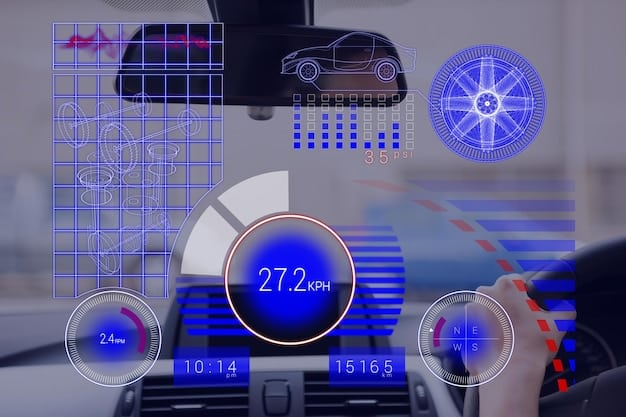US Electric Vehicle Exports Surge: A 25% Increase in 6 Months

Electric Vehicle Export News: United States electric vehicle manufacturers have experienced a significant surge in exports, marking a 25% increase in the last six months, driven by rising global demand and advancements in EV technology.
The American electric vehicle (EV) industry is making waves globally, with recent Electric Vehicle Export News highlighting a remarkable 25% increase in exports over the past six months. This surge signals a boost in international demand and the growing competitiveness of US-made EVs.
Electric Vehicle Export News: A Detailed Overview of the Surge
The electric vehicle market is rapidly expanding, and the United States is emerging as a key player in EV exports. Recent data indicates that US electric vehicle manufacturers have significantly increased their export volumes. Let us dive into the numbers and examine the factors that contribute to this exciting trend.
Key Statistics and Figures
A 25% increase in electric vehicle exports in just six months is not just a number; it is a testament to the growing strength and appeal of American-made EVs.

Several factors are helping contribute to this statistic. These factors include:
- Increasing production capacities.
- Growing international demand for EVs.
- Advancements in EV technology and performance.
The surge in exports reflects the industry’s increasing production efficiency, coupled with growing enthusiasm for EVs worldwide.
Factors Fueling the US Electric Vehicle Export Boom
Several factors are fueling the increasing exports of electric vehicles from the United States. These range from policy support, technological advancements, to the increasing appeal of EVs in international markets. Let’s take a look at the main drivers behind this surge.
Government Incentives and Policies
Government initiatives play a significant role in promoting the production and export of electric vehicles. Incentives such as tax credits, subsidies, and grants stimulate the EV industry.
Specific policies include:
- Tax credits for EV manufacturers.
- Subsidies for EV research and development.
- Grants for infrastructure development supporting EV adoption.
The policies collectively create a favorable environment for EV production and exports, strengthening the competitiveness of the industry.
Technological Advancements in US Electric Vehicles
Significant technological advancements in US electric vehicles are making them more attractive to international buyers. Continuous improvements in battery technology, vehicle performance, and charging infrastructure are key factors.
Let’s explore these improvements and understand the positive impact on exports.

Innovations in Battery Technology
US manufacturers are leading the way in battery tech, focusing on increased energy density and improved energy retention. Battery tech improvements can greatly influence export demand.
Performance Capabilities and Range
The range and performance capabilities of EVs from the US have improved recently. This draws more international purchasers who have range anxiety or depend more on high performance vehicles.
Advancements in technology and performance continue to drive consumer demand and export opportunities.
The Impact of Rising Global Demand for Electric Vehicles
Global demand for electric vehicles is on the rise as more countries commit to reducing carbon emissions and transitioning to sustainable transportation. The increased demand creates a substantial market for US manufacturers.
The demand is influenced by factors
- Stringent emission standards driving EV adoption.
- Growing environmental consciousness among consumers.
- Government initiatives promoting the transition to EVs.
The rising global demand presents significant opportunities for US manufacturers to expand their market presence.
Challenges and Opportunities for US Electric Vehicle Exporters
Despite the positive trends, US electric vehicle exporters face challenges and opportunities to navigate to sustain growth. These include trade policies, infrastructure limitations, and competition from other global players.
Navigating International Trade Policies
International trade policies impact the accessibility and competitiveness of US electric vehicles in foreign markets. Tariffs, trade agreements, and regulatory standards dictate the cost and viability of exports.
These challenges can be overcome by:
- Advocating for favorable trade policies.
- Diversifying export markets to reduce dependence on specific regions.
- Complying with regulatory standards in target markets.
Strategic navigation of trade policies is essential for maintaining a strong export position.
The Future Outlook for US Electric Vehicle Exports
The future looks promising for US electric vehicle exports, with projections indicating continued growth and expansion. Factors driving this positive outlook include ongoing technological advancements, supportive government policies, and rising global demand.
In conclusion, the US electric vehicle industry is on a path to sustained export success.
| Key Point | Brief Description |
|---|---|
| 📈 Export Growth | US EV exports increased by 25% in the last 6 months. |
| 💰 Government Support | Incentives and policies drive EV production and exports. |
| 🔋 Tech Advancements | Innovations in battery tech boost EV appeal. |
| 🌍 Global Demand | Rising global demand creates export opportunities for US EVs. |
FAQ Section
▼
The primary drivers include growing global demand, supportive government policies, and technological advancements in US-made electric vehicles, making them more attractive to international buyers.
▼
Government incentives, such as tax credits and subsidies, reduce production costs and encourage research and development, enhancing the competitiveness of US EVs in the global market.
▼
Innovations in battery technology, increased vehicle range, and improved charging infrastructure are making US EVs more appealing to international consumers seeking high-performance, reliable electric vehicles.
▼
Challenges include navigating international trade policies, addressing infrastructure limitations in export markets, and competing with other global players in the electric vehicle industry.
▼
The future outlook is positive, with continued growth projected due to ongoing technological advancements, supportive government policies, and increasing global demand for electric vehicles.
Conclusion
In summary, the US electric vehicle sector is making significant strides in the global market, primarily due to a combination of government backing and innovative developments. With continued investment and strategic enhancements, the United States is well-positioned to maintain its upward trajectory in electric vehicle exports.





